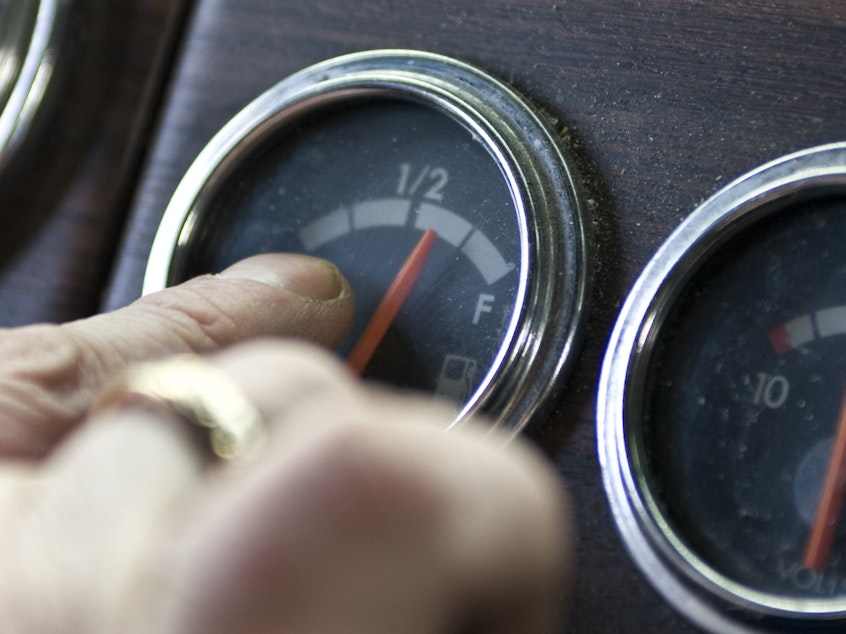Biden administration proposes new fuel economy standards, with higher bar for trucks

Federal highway regulators have proposed new fuel economy standards that would require cars to improve their fuel economy by 2% every year, and light trucks by 4% each year, through 2032.
Environmental groups say the new rules are insufficiently ambitious, given the urgent need to fight climate change. The major automaker trade group says it's reviewing the proposal.
Under the proposed standards from the National Highway Transportation Safety Administration, fleet-wide fuel economy for new vehicles would be pushed close to 58 miles per gallon by 2032. That's up from the 49 mpg required by 2026 under the current iteration of the rules. (Because of how fuel economy is calculated for these regulations, the actual miles per gallon drivers would see on the road would be significantly lower, even for compliant vehicles.)
Automakers face hefty fees when they fall short of fuel economy requirements, which are known as Corporate Average Fuel Economy, or CAFE, standards.
The proposal will be open for public comment for 60 days.
Rules come after EPA's ambitious push toward EVs
Vehicle fuel economy and emissions in the U.S. are regulated by three different bodies. California, a state with unique influence, sets increasingly stringent requirements that other states can choose to follow. The Environmental Protection Agency regulates vehicle emissions nationwide, including pollution and greenhouse gases. And NHTSA regulates fuel economy, with an original mandate of improving America's energy security by reducing reliance on oil.
At one point the three bodies coordinated to set shared standards, but they have since split back apart. But under the Biden administration, all three are pushing in the same general direction: EVs. Electric vehicles use no gasoline and have no tailpipe emissions, and even counting the emissions from manufacturing them and producing electricity, they are cleaner than similar hybrids, and significantly cleaner than conventional gas- and diesel-powered vehicles.
California is now pushing for 100% electric vehicles by 2035. As for the EPA, earlier this year it proposed standards for vehicle emissions that surprised the auto industry with their ambitious push toward electric vehicles. The EPA's standards, if approved, would result in electric vehicles making up 67% of new vehicle sales by 2032.
Currently, EVs make up just over 7% of sales. BloombergNEF recently projected they're on pace to hit 28% by 2026. That's rapid growth — but not on track to hit the EPA's target. Analysts have also found that even recent, significant announcements in charging infrastructure fall short of what a rapid transition to EVs would require.
Environmentalists and the EV industry largely celebrated the EPA's proposal, while the trade group representing legacy automakers has called the proposal "neither reasonable nor achievable."
As EVs increase, what about fuel economy?
The EPA rules were crafted so they would be essentially impossible to meet without producing zer0-emission vehicles. NHTSA's fuel economy standards, in contrast, have to be designed so they could be met just by making gas and diesel vehicles more efficient.
However, as manufacturers make more EVs, it will help them meet the fuel economy standards, which are calculated across a manufacturers' entire fleet.
Behind the new standards is a big question for the auto industry: how much money needs to be put into improving gas-powered vehicles if the future is mostly electric? Some automakers argue that money spent improving their gas-powered vehicles will just hamper their ability to switch to EVs. Currently, gas-powered vehicles are more profitable than electric ones for legacy automakers, and revenue from internal combustion vehicles is funding EV investments.
Environmental groups, meanwhile, say the industry needs to go electric and simultaneously make much greener gas-powered cars, given that gas-powered cars built today could drive for decades.
The Alliance for Automotive Innovation, while still parsing the rules, noted that it appears "at first glance" like NHTSA tried to align its standards with the EPA's standards. On the one hand, the Alliance has objected to those standards as unrealistic. On the other hand, the group does strongly prefer for the various standards to match up as much as possible.
Early feedback from environmental groups, meanwhile, argued NHTSA should push for faster improvements in gas-powered vehicles.
"Given the pace of technological change and urgent need to conserve energy, it's clear that these standards could be even more ambitious than NHTSA's proposal," Dave Cook, senior vehicles analyst for the Union of Concerned Scientists' Clean Transportation Program, said in a statement.
Faster improvement for trucks
One element of the proposal has long been a focus for environmentalists: Stricter standards for trucks.
U.S. vehicles have gotten significantly more efficient over time. However, many of those gains were effectively erased as larger vehicles, like SUVs, replaced fuel-sipping sedans on America's roads.
Vehicle standards have helped drive that improved efficiency. But critics have noted that by having looser standards for larger vehicles, those same rules also contributed to the increase in SUVs and trucks.
The proposed new fuel economy standards would require SUVs and pick-ups to improve at a faster clip than smaller vehicles because there is "more room to improve" the fuel economy of larger vehicles, as NHTSA puts it — and because improved economy in those vehicles will have a disproportionate benefit given their popularity and the amount of fuel they consume.
Large, feature-packed, not-very-fuel-efficient trucks are a major money-driver for the Detroit 3. General Motors and Stellantis (formerly known as Fiat Chrysler) have each paid out more than $100 million in fees for CAFE non-compliance over the last six years, according to NHTSA's public data. [Copyright 2023 NPR]



